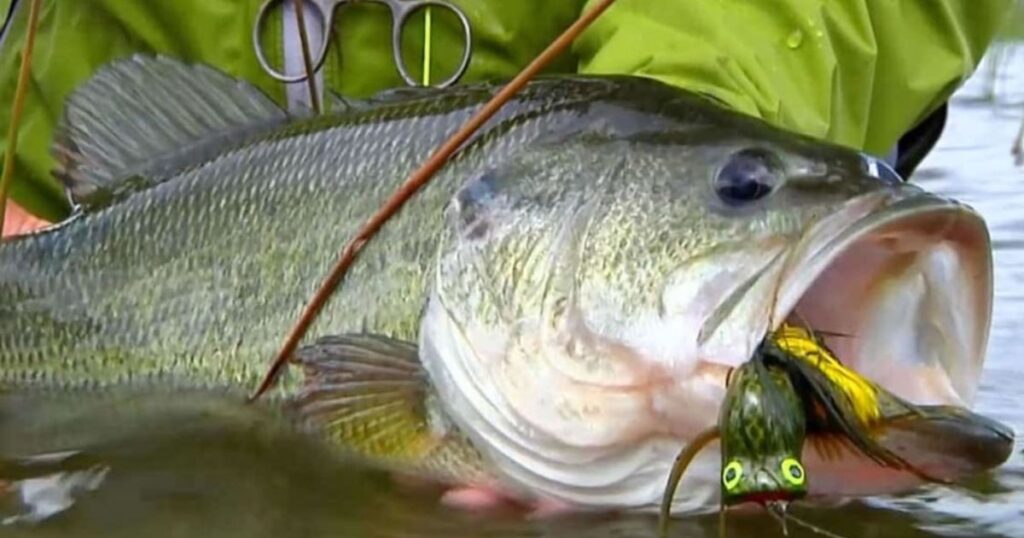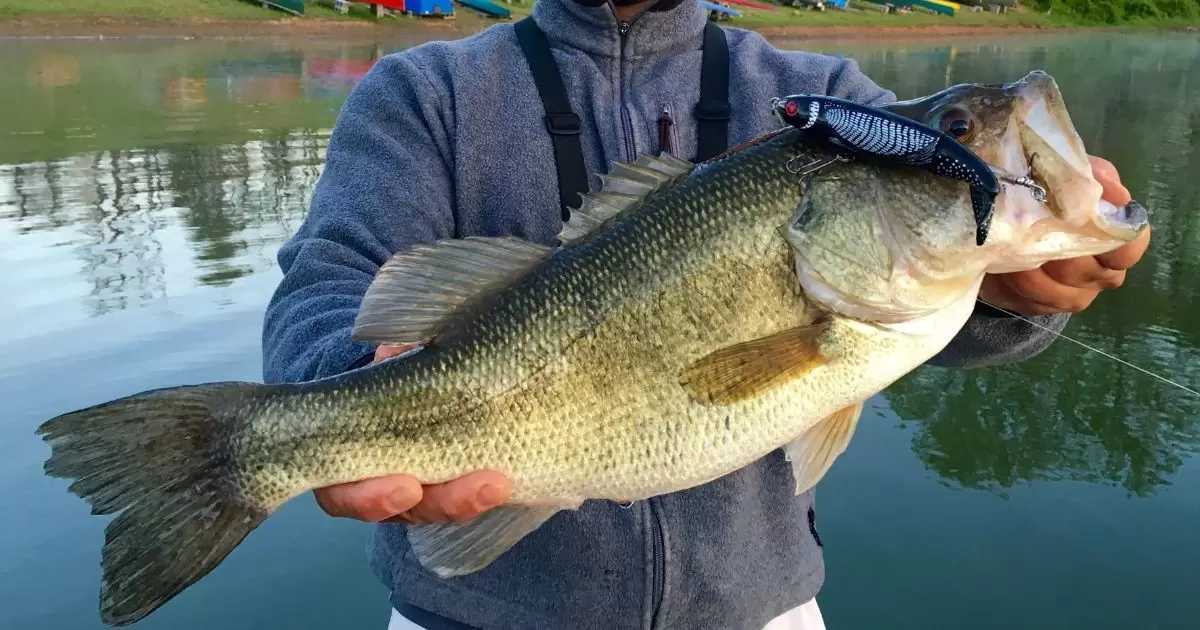Fly fishing for bass is a method of fishing where anglers use specialized fly fishing gear and techniques to catch bass, a popular freshwater fish species. Fly fishing for bass is an exciting and challenging way to pursue these predatory fish. Anglers cast lightweight artificial flies to mimic natural prey, such as insects or small fish, onto the water’s surface. Bass are known for their aggressive strikes, making fly fishing a thrilling and rewarding experience for those who enjoy the sport.
If you’ve ever wondered how to fly fish for bass, you’re in for an adventure like no other. With the serene rhythm of casting lightweight flies and the heart-pounding excitement of bass strikes, this method offers a unique and thrilling angling experience. Learn the art of precision and patience as you explore the world of fly fishing for these formidable freshwater predators.
Whether you’re a seasoned angler looking for a new challenge or a beginner eager to explore the world of fly fishing, mastering this technique for bass is an engaging pursuit that promises unforgettable moments by the water.
The Right Gear for Fly Fishing Bass
Selecting the right gear is fundamental for successful fly fishing for bass. A versatile 7-weight fly rod with a weight-forward floating line provides the backbone. A balanced reel with a smooth drag system and a suitable leader-tippet setup ensure control during the fight. Choose flies that mimic local prey, enhancing your chances of landing that trophy bass. Proper gear is your gateway to a rewarding bass fly fishing experience.
Fly Rod Select a medium to fast-action fly rod with a weight rating of 6 to 8. A 9-foot, 7-weight rod is an excellent all-around choice for bass.
Fly Reel Choose a reel that balances well with your rod and has a smooth drag system to handle the strong bass runs.
Fly Line For bass, a weight-forward floating line is a great choice. It allows for accurate casting and precise presentation of your fly.
Leader and Tippet Use a short, heavy leader (around 7.5 feet) tapered to 12-16 pounds, followed by a tippet of 8-10 pounds. This setup helps you turn over larger flies and handle aggressive strikes.
Flies Bass flies come in various patterns and sizes. Common choices include poppers, streamers, and crayfish imitations. Experiment with different colors and sizes to match the local prey.
Accessories A good pair of polarized sunglasses, a hat, and reliable wading gear are essential for comfort and safety on the water.
Techniques for Fly Fishing Bass

The Art of Casting Mastering casting is the cornerstone of fly fishing. Practice your casting techniques to achieve accuracy and distance. With bass, precision counts as they often lurk near structures or along the shoreline.
Presentation Bass are known for their explosive surface strikes. Cast your fly near the cover or structure, and let it sit momentarily. Then, impart gentle twitches and pops to mimic the movement of prey. Watch for any sudden swirls or strikes.
Retrieval Styles Experiment with various retrieval methods, such as slow, steady retrieve, quick strips, or erratic jerks to trigger bass into striking. Adapt your approach based on the bass’s response.
Line Control Maintain a tight line to be ready for an aggressive strike. Feel for any subtle tension or movement and be prepared to set the hook swiftly.
Water Conditions Pay attention to water temperature and weather patterns. Bass activity can vary based on these factors. Early mornings and evenings are prime times for surface action, but bass can be caught throughout the day.
Fly Fishing Strategies for Different Bass Species
Each bass species has its unique characteristics, and tailoring your approach accordingly can enhance your success.
Largemouth Bass Largemouth bass are ambush predators. Target them near submerged vegetation, lily pads, fallen trees, and rocky banks. Poppers and weedless flies work well in these habitats.
Smallmouth Bass Smallmouth bass are often found in clear, rocky streams and rivers. Use streamers and crayfish patterns to entice them. Pay attention to the speed and depth of your presentation.
Spotted Bass Spotted bass are typically smaller but no less aggressive. They inhabit a variety of environments, so adapt your strategy to the local conditions. Smaller poppers and streamers are effective choices.
Catching Bass On A Fly Every Time
Under tips, when applied effectively, can increase your chances of successfully fly fishing for bass and enhance your overall angling experience.
| Tip | Description |
| 1. Understand Bass Behavior | Learn about bass habits, feeding patterns, preferred habitats, and seasonal movements to target them effectively. |
| 2. Use the Right Fly | Choose fly patterns that mimic local prey or the specific prey bass are feeding on. Experiment with different flies to find what works. |
| 3. Learn to Cast | Develop good casting skills, focusing on accuracy and distance, which are crucial for success in fly fishing for bass. |
| 4. Stay Stealthy | Approach the water quietly and avoid sudden movements that could spook bass. |
| 5. Observe the Water | Look for signs of bass activity, such as surface swirls, jumping fish, or bird activity, to locate feeding bass. |
| 6. Vary Your Retrieve | Experiment with different retrieval techniques, such as slow strips, fast strips, erratic jerks, and pauses, to trigger strikes by changing the presentation. |
| 7. Fish Different Depths | Bass can be found at various depths. Target fish near the surface, in the mid-water column, or near the bottom based on the conditions. |
| 8. Be Patient | Allow the fly to drift or sit still for a moment, as bass may not strike immediately. Patience can tempt cautious bass into biting. |
| 9. Change Your Fly Size | If you’re not getting bites, switch to a smaller or larger fly to see if it piques the fish’s interest. |
| 10. Observe Local Conditions | Pay attention to weather, water temperature, and seasonal changes, as bass activity varies with these factors. Adjust your tactics accordingly. |
| 11. Fish During Optimal Times | Plan your outings during early morning and late evening, prime times for surface feeding by bass. |
| 12. Safety and Conservation | Prioritize safety on the water and practice catch and release to help conserve bass populations for future generations. |
How Do You Catch Bass On Files?
Catching bass on flies, also known as fly fishing for bass, requires some specific techniques and strategies. Fish A Jig For Bass Here’s a step-by-step guide on how to catch bass using flies.

- Gear Selection
- Choose a fly rod designed for bass fishing. A 7 to 9-foot, 6 to 8-weight rod is ideal for most bass species.
- Pair your rod with an appropriate fly reel equipped with a smooth drag system.
- Use weight-forward floating fly lines for bass fishing, as they allow for accurate casting and presentation.
- Selecting Flies
- Choose fly patterns that imitate the local prey of bass. Common bass flies include poppers, streamers, and crayfish imitations.
- Experiment with various colors, sizes, and patterns to see what attracts the bass in your area.
- Understanding Bass Behavior
- Learn about bass habits, such as their preferred habitats, feeding patterns, and seasonal movements.
- Bass are opportunistic feeders, so understanding their prey choices can help you select the right fly.
- Casting Techniques
- Practice your casting skills to achieve accuracy and distance. Bass often lurk near structures or along the shoreline, so precision is crucial.
- Use techniques like false casting and roll casting to present your fly accurately.
- Retrieval Styles
- Experiment with different retrieval methods, including slow and steady retrieves, quick strips, and erratic jerks.
- Match your retrieval style to the behavior of the bass; sometimes, changing the presentation can trigger strikes.
- Presentation:
- Cast your fly near cover or structure, such as submerged logs, weed beds, or rocky points, where bass often hide.
- Let the fly sit for a moment to mimic a resting prey, and then add gentle twitches or pops to simulate movement.
- Observation
- Pay close attention to the water’s surface for signs of bass activity, such as surface swirls, jumping fish, or birds diving for prey.
- These cues can help you locate feeding bass.
- Retrieve Control
- Maintain a tight line to be ready for a sudden strike. Feel for any subtle tension or movement that might indicate a bass’s interest.
- Fish at Optimal Times:
- Bass are more active during early morning and late evening. These times are prime for surface feeding, so plan your outings accordingly.
- Patience
- Bass may not always strike immediately. Be patient and let the fly linger, as this can tempt cautious bass into biting.
- Safety and Conservation
- Prioritize safety while fishing, especially when wading in streams or rivers. Use wading gear and consider wearing a personal flotation device (PFD).
- Practice catch and release to protect bass populations and their habitats.
- Local Knowledge
- Seek advice and information from local anglers or fishing communities. Local knowledge can provide valuable insights into the best spots, effective fly patterns, and recent fishing reports.
FAQs
Is fly fishing for bass suitable for beginners?
Yes, fly fishing for bass can be enjoyed by beginners. It may have a learning curve, but with practice and patience, newcomers can experience success and have a rewarding fishing experience.
What time of day is best for fly fishing for bass?
Early mornings and evenings are generally the best times for surface action as bass tend to be more active during these periods. However, bass can be caught throughout the day, so it’s worth trying different times.
What are the most effective fly patterns for bass?
Effective fly patterns for bass include poppers, streamers, crayfish imitations, and baitfish patterns. The best choice often depends on the specific location and the prey species that bass are targeting.
Can I use the same gear for different bass species?
While you can use the same gear for different bass species, it’s often beneficial to tailor your gear and approach to the specific habitat and behavior of the bass species you’re targeting. Smallmouth bass, for example, prefer different environments than largemouth bass.
Is catch and release necessary when fly fishing for bass?
Catch and release is strongly encouraged in fly fishing for bass to promote conservation and protect fish populations. Ethical catch and release practices, such as using barbless hooks and handling fish gently, help ensure the sustainability of bass populations for future generations of anglers.
Conclusion
To learn how to fly fish for bass, you embark on an exciting adventure. Understanding bass behavior, selecting the appropriate gear, and honing your techniques are vital. Picking the right fly patterns and having patience are key to success.
The optimal times to fish are early mornings and late evenings, maximizing your chances of success. Safety and conservation are paramount; always practice catch and release to preserve bass populations and their habitat. Fly fishing for bass provides a special link to the outdoors, making it a deeply rewarding and enduring passion for those who embrace it.

